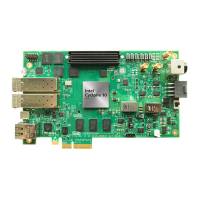
Do you have a question about the Intel Cyclone 10 GX FPGA and is the answer not in the manual?
| Family | Cyclone 10 GX |
|---|---|
| Category | FPGA |
| Manufacturer | Intel |
| Technology Node | 20 nm |
| Transceiver Data Rate | up to 12.5 Gbps |
| Power Supply Voltage | 1.2 V |
| Operating Temperature | -40°C to 100°C |
| Package Options | FBGA |
Details the Intel Cyclone 10 GX FPGA Development Kit and its components.
Specifies operating temperature, load current, and power consumption limits.
Provides essential precautions for handling the development board.
Guides on installing the Intel Quartus Prime design software.
Instructions for downloading, extracting, and understanding the development kit package.
Details the installation of the Intel FPGA Download Cable driver.
Instructions for preparing and applying power to the development kit.
Lists the default factory settings for DIP switches and jumpers.
Provides a block diagram and lists major components of the Intel Cyclone 10 GX FPGA Development Kit.
Details the maximum resource availability and I/O allocation of the Intel Cyclone 10 GX FPGA.
Highlights the features and applications of the Intel MAX 10 device as a system controller.
Explains the JTAG topology and various methods for configuring the FPGA.
Covers user I/O components like switches, LEDs, and pushbuttons.
Describes the DDR3 memory implementation and its high-speed interface.
Details the user accessible QSPI Flash memory for data storage.
Details the allocation and capabilities of the 12 transceiver channels.
Describes the PCIe x4 Gen2 interface, its signals, and power requirements.
Covers the SFP+ connectors for high-speed network connectivity.
Details the USB3.1 Type-C interface supporting SuperSpeed and USB2.0.
Describes the FMC connector and its compatibility with daughter cards.
Explains the copper Ethernet connector interface and its associated PHY.
Describes how power and peripherals are managed via the I2C/PMBUS.
Guides on preparing the board and prerequisites for using the BTS application.
Step-by-step instructions on how to execute the Board Test System application.
Details the controls and features available within the BTS application.
Explains how to select and load FPGA designs for testing within the BTS.
Describes the System Info tab for viewing board configuration and hardware details.
Explains interaction with user I/O components like switches, LEDs, and buttons.
Allows reading and writing EPCQ flash memory for configuration.
Enables performing loopback tests on PCIe and SFP+ transceiver ports.
Allows performing loopback tests on the FMC port for functionality verification.
Allows reading and writing DDR3 memory for testing and analysis.
Measures and reports current power information and consumption of the board.
Allows setting programmable oscillators for frequency control and distribution.
Covers safety warnings, FCC compliance, and general regulatory information.
Details hazardous voltage, power connection, grounding, and cord requirements.
Warns about hot surfaces, sharp edges, thermal, mechanical hazards, and cooling.
Provides CE EMI conformity caution regarding electromagnetic interference.
Lists the dates, versions, and descriptions of User Guide revisions.